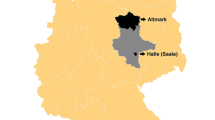Summary
The “Myocardial Infarction Registry” in Germany (MIR) is a multicenter and prospective registry of consecutively included, unselected patients with acute myocardial infarction. The purpose of MIR is to document the actual praxis of decision making and prescribing of an optimized infarction therapy in AMI patients. Optimized infarction therapy is defined as the combination of reperfusion therapy and ASS, betablocker, and ACE inhibitor.
14,598 patients with acute myocardial infarction were included between 12/96 and 5/98 in 217 hospitals throughout Germany. 68% of the patients were male; mean age was 67 years. The prehospital delay time was 195 minutes in median, the first ECG was diagnostic in 66% of the patients. A reperfusion therapy was applied in 46.1% of the patients (thrombolysis 36.2%, primary PTCA 9.9%). During the acute phase, the following adjunctive therapy was used: ASS in 90.3%, betablockers in 53.8%, and ACE inhibitors in 52.5%. Intrahospital mortality was 15.4%. Compared to hospitals without cardiologists, the hospitals with cardiologist had a lower intrahospital mortality (13.8% versus 16.1%; p < 0.001). Reasons are the more frequent use of a reperfusion therapy by cardiologists (54.3% versus 42.3%; p < 0.001) and the availability of a catheter laboratory with PTCA facilities.
A lower intrahospital mortality was associated with each therapy of the optimized infarction therapy: reperfusion therapy (odds ratio 0.7; 95% CI: 0.5–0.8), ASS (odds ratio 0.6; 95% CI: 0.5–0.8), betablocker (odds ratio 0.6; 95% CI: 0.5–0.7) and ACE inhibitor (odds ratio: 0.5; 95% CI: 0.4–0.7). However, patients with poor initial prognosis – such as cardiogenic shock, hypotension and/or bradycardia – could not benefit from the orally adjunctive therapy. This fact may have led to an overestimation of the influence on intrahospital mortality.
In representative communal German hospitals, a reperfusion therapy in combination with an optimized adjunctive therapy in patients with acute myocardial infarction is associated with a reduction in intrahospital mortality. Compared to previous registries, the application of betablockers and ACE inhibitors was clearly increased. Reasons could be the participation in a quality registry, the obligation to document why a therapy has not been given and repeated and intensified education of the treating physicians.
Thus, the mainly communal hospitals in Germany are increasingly following recommendations about the early treatment of acute myocardial infarction. Myocardial infarction registries such as MIR reflect daily prescribing habits in hospitals and describe the implementation of the results of randomized trials into daily routine.
Zusammenfassung
Das Myokardinfarktregister in Deutschland (MIR) ist ein multizentrisch und prospektiv angelegtes Register von konsekutiv eingeschlossenen, unselektierten Patienten mit akutem Myokardinfarkt. Ziel des MIR ist eine Dokumentation der Entscheidungs- und Verordnungspraxis einer optimierten Infarkttherapie, bestehend aus rekanalisierender Therapie, ASS, Betablocker und ACE-Hemmer-Gabe. Von 12/96–5/98 wurden bundesweit 14598 Patienten mit akutem Myokardinfarkt in 217 Krankenhäusern eingeschlossen. Von diesen nahmen 68 Kliniken aus den neuen Bundesländern teil. 65% der Patienten waren männlich, das mittlere Alter betrug 67 Jahre. Die Prähospitalzeit lag im Median bei 195 min, das Erst-EKG war bei 66% der Patienten diagnostisch. Eine rekanalisierende Therapie erhielten 46,1% der Patienten (hospitale Thrombolyse 36,2%; Primär-PTCA 9,9%). Als Begleitmedikation in der Akutphase wurden verordnet: ASS bei 90,3%, Betablocker bei 53,8% und ACE-Hemmer bei 52,5%. Die intrahospitale Gesamtmortalität betrug 15,4%. Im Vergleich zeigte sich in kardiologischen Fachabteilungen eine niedrigere Gesamtmortalität (13,8%) gegenüber den Krankenhäusern der Regelversorgung (16,1%). Als mögliche Gründe fanden sich der häufigere Gebrauch einer rekanalisierenden Therapie in Krankenhäusern mit kardiologischer Fachabteilung (54,3% versus 42,3%; p < 0,001) und das Vorhandensein eines Katheterlabors mit PTCA-Möglichkeit.
Eine niedrigere intrahospitale Mortalität im Gesamtkollektiv war mit allen Therapiebausteinen der optimierten Infarkttherapie assoziiert: rekanalisierende Therapie (odds ratio 0,7; 95%-KI: 0,5–0,8), Gabe von ASS (odds ratio 0,6; 95%-KI: 0,5–0,8), Betablocker (odds ratio 0,6; 95%-KI: 0,5–0,7) und ACE-Hemmer (odds ratio 0,5, 95%-KI: 0,4–0,7). In dieser Analyse konnten Patienten mit schlechter Prognose – z. B. kardiogener Schock, Hypotension und/oder Bradykardie bei Aufnahme und Frühverstorbene –, die nicht der oralen adjuvanten Infarkttherapie zugeführt werden konnten, nicht berücksichtigt werden. Der Einfluß der adjuvanten Therapie auf die Senkung der intrahospitalen Mortalität wird dadurch möglicherweise überschätzt.
Im Klinikalltag ist einem repräsentativen Anteil von Krankenhäusern Deutschlands eine rekanalisierende Therapie in Kombination mit einer optimierten adjuvanten Therapie beim akuten Myokardinfarkt assoziiert mit einer Senkung der intrahospitalen Mortalität. Im Vergleich zu vorausgegangenen ähnliche Registern ließ sich der Therapieanteil der Betablocker und ACE-Hemmer deutlich steigern. Dies läßt sich mit der Teilnahme an einem Qualitätsregister, der Verpflichtung der Dokumentation, warum eine Therapie nicht gegeben wurde, und einer wiederholten und intensivierten Aufklärungsaktion der behandelnden Ärzte begründen. Den Empfehlungen zur Frühbehandlung des akuten Myokardinfarktes wird somit im Klinikalltag der überwiegend kommunalen Krankenhäuser zunehmend entsprochen.
Myokardinfarktregister wie MIR reflektieren die tägliche Verordnungspraxis im Krankenhaus und beschreiben die Umsetzung der Ergebnisse großer randomisierter Studien in den Klinikalltag.
Similar content being viewed by others
Author information
Authors and Affiliations
Additional information
Eingegangen: 23. Februar 1999, Akzeptiert: 11. Mai 1999
Rights and permissions
About this article
Cite this article
Wagner, S., Schneider, S., Schiele, R. et al. Akuter Myokardinfarkt in Deutschland im Zeitraum zwischen 1996 und 1998: Therapie und hospitaler Verlauf Ergebnisse des Myokardinfarktregisters (MIR) in Deutschland. Z Kardiol 88, 857–867 (1999). https://doi.org/10.1007/s003920050362
Issue Date:
DOI: https://doi.org/10.1007/s003920050362




